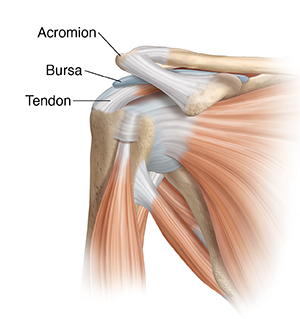Understanding Shoulder Impingement Syndrome
Understanding Shoulder Impingement Syndrome

What causes shoulder impingement syndrome?
It is possible to develop impingement after years of normal shoulder use. But in most cases the condition occurs because of repeated overhead movements. These include such things as stocking shelves, painting, swimming, and throwing. These movements can irritate parts of the shoulder, leading to swelling. Swollen parts of the shoulder take up more room, making the joint space smaller. Some parts that may be involved include:
A sac of fluid (bursa) that cushions the shoulder joint. When the bursa is irritated, it may lead to a condition called bursitis. This is when the bursa swells with fluid, filling and squeezing the joint space.
Fibrous tissues (tendons) that connect muscle to bone. When tendons are irritated, they may become swollen. This is called tendonitis.
The end (acromion) of the shoulder blade. This bone may be flat or hooked. If the acromion is hooked, the joint space may be smaller than normal. Growths (bone spurs) on the acromion can also narrow the joint space. Acromion problems don’t often cause impingement. But they can make it worse.
Symptoms of shoulder impingement syndrome
Symptoms include pain, pinching, or stiffness in your shoulder. Pain often comes with movement, particularly reaching overhead or backward. It may also be felt when the shoulder is at rest. Pain at night during sleep is common.
Treatment for shoulder impingement syndrome
Treatment will depend on the cause of the problem, how bad the problem is, and if other parts of the shoulder are damaged. Treatment may include the following:
Active rest. This allows the shoulder to heal. It means using the arm and shoulder, but avoiding activities that cause pain. These likely include reaching overhead or sleeping on your shoulder.
Cold packs. These help reduce swelling and relieve pain.
Prescription or over-the-counter pain medicines. These help relieve pain and swelling.
Arm and shoulder exercises. These help keep your shoulder joint mobile as it heals. They also help improve muscle strength around the joint.
Shots of medicine into the joint. This can help reduce swelling and pain for a short time.
If other measures don’t work to relieve symptoms, you may need surgery. This opens up space in the joint to allow pain-free motion.
Possible complications of shoulder impingement syndrome
It might be tempting to stop using your shoulder completely to avoid pain. But doing so may lead to a condition called frozen shoulder. To help prevent this, follow instructions you are given for active rest and for doing exercises to help your shoulder heal.
When to call your healthcare provider
Call your healthcare provider right away if you have any of these:
Fever of 100.4°F (38°C) or higher, or as directed
Symptoms that don’t get better, or get worse
New symptoms
Updated:
June 24, 2017
Sources:
Parsons C. Rehabilitation principles and practice for shoulder impingement and related problems. Up To Date. December 2 ed: Up To Date; 2015. p. 18., Sanfran MR, et al. Secondary Impingement Syndrome. In: Sanfran MR, editor. Instructions for Sports Medicine Patients. Philadelphia: Saunders; 2012. p. 943-53., Simons SM, et al. Shoulder impingement syndrome. Up To Date. May 5 ed: Up To Date; 2014. p. 11., Waldman SD. An Overview of Shoulder Impingement Syndromes. In: Waldman SD, editor. Physical Diagnosis of Pain. Philadelphia: Elsevier; 2016. p. 64-7.
Reviewed By:
Bellendir, Trina, MSPT, CLT,Image reviewed by StayWell medical illustration team.,Joseph, Thomas N, MD